Indulge me, if you will, in a lament for RPGs of years gone by.
Back in the day you’d start off a RPG a weak and pitiful creature, one barely able to slay the level 1 rats that were sent your way. Then over the course of many hours you’d increase your own power substantially, the game doing so in concert in a (hopefully) balanced way. However there’d always come a point where you’d become unfathomably powerful, enough so that even the game’s hardest challenges could be done without much thought. To be sure the challenge in the game at that point is gone but it also grants you freedom to explore the rest of the game however you want, freed from the grasps of the game’s claws. It seems that the advent of Dark Souls has pushed everyone to make games punishing with every new power coming a new counter to ensure that it never gets out of control. I don’t count this against games, to be sure it’s more of a sign of game’s recieving more polish than they used to, but I can’t say I don’t miss the times where I could one shot bosses at the end of a play through.
I give this preamble because I went into Ghost of Tsushima completely blind and initially felt like I might be walking into yet another soulslike experience. Thankfully it’s not but it didn’t take long for me to figure out that I’d never become the unstoppable samurai warrior I wanted to be. The game does make up for this in some regards however it’s open world nature which tends towards high repetition of the core game loop did mean that the game started to drag for me after a while. Still for those who love to immerse themselves in a title for hours on end it’s up there to be the best example of that style of game this year.
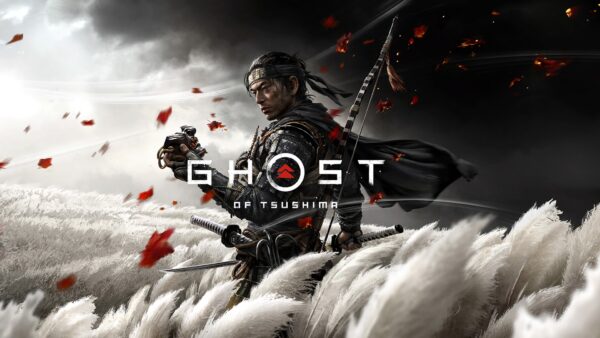
In 1274, a Mongolian invasion fleet led by Khotun Khan lands on the Japanese island of Tsushima. Jin Sakai joins with the rest of the island’s local samurai, led by his uncle Lord Shimura, in an attempt to repel the invasion. However, the battle ends in disaster, with the entire samurai army killed, Lord Shimura captured, and Jin grievously wounded and left for dead. Jin is found and nursed back to health by Yuna, a local thief, who informs him that most of Tsushima has already fallen to the Mongols. Jin storms Khotun’s stronghold at Castle Kaneda in an attempt to rescue Lord Shimura, but is defeated by Khotun in combat and is thrown from a bridge. So begins his voyage to gain allies, strength and the courage to take down the mongols that have invaded his homeland.
Ghost of Tsushima is an absolutely stunning game giving The Last of Us Part II a good run for its money for best looking game released on the PlayStation 4 console. The environments are simply overflowing with details and whilst there may be some creative license taken with the amount of foliage that flows around you I can’t say I didn’t enjoy it. It’s clear that they’re making full use of all of the PlayStation’s horespower and every trick that the Unreal 5 engine can put forward. Surprisingly this also comes without a whiff of performance issues either with the framerate never missing a beat and the load times be surprisingly swift. Really at this point it’s clear that the PlayStation platform has been pushed for all its worth and the new generation that we’ll see coming at the end of the year is well timed to say the least.
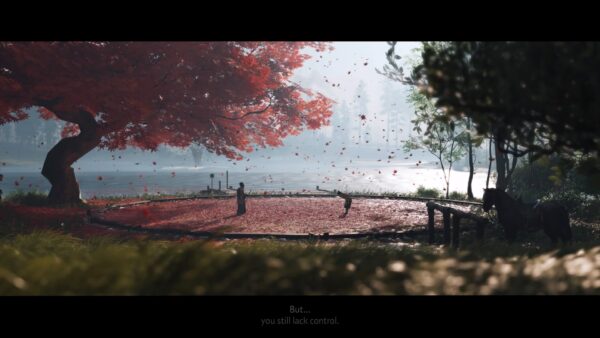
Ghost of Tsushima is an open world game in all respects, giving you a core set of missions to pursue wholly at your leisure. There’s a smattering of side quests that will be thrown your way from the quick single objective ones to others that’ll lead you on wild goose chases all over the map. There’s a couple progression systems thrown in with some familiar tropes and some others which take inspiration from the souls games that it seeks to emulate in a rudimentary fashion. Of course no open world game is complete without an inordinate amount of collectibles, some of which will do absolutely nothing for you whilst others may reward you with a shiny new saddle for your horse (which also does nothing). There’s stealth as well although, given the game actively discourages (and in a way kinda punishes) you against it I’m not quite sure to make of it. Although the game will bitch and moan at you about not being able to use “online features” if you don’t update it I can’t actually see any included here which honestly isn’t a bad thing since they’re usually a tacked on distraction. There’s more of course but it all follows the standard open world tropes so closely that if you’ve played any of them in the past decade you’ll know the core of what Ghost of Tsushima is putting forward here.
Combat is akin to the beat ’em up style that the Arkham series of games made popular, often pitting you against a group of varied enemies which you’ll have to use your various abilities against in order to overcome their defenses so you can pummel the crap out of them. In this game that comes in the form of “stances” which you’ll unlock at a steady pace as you kill leaders who are dotted around the map. These stances are effectively different kinds of combat that are more effective against their specific opponent type, of which there are 4: swordsmen, spearmen, shield bearers and brutes. If I’m honest I made it through a really good chunk of the game only using the shield bearer one until I unlocked the spear one, at which point it seemed to become woefully ineffective. From them on it became a constant game of stance matching whatever opponent I was up against which, honestly, got pretty tiring towards the end.
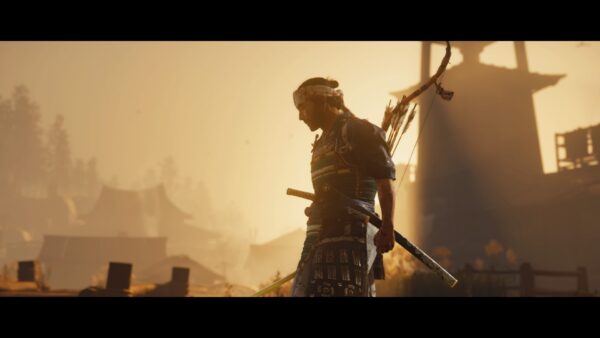
You see in the beginning, where the number and variety of enemies is small, switching stances up once or twice during a fight is no biggie, all part of the combat loop. Later on in the game though? You’ll be changing stances against basically every single foe since they’ll end up swarming you with massive numbers. You also can’t not change stances either as you’ll do basically no damage and the game will routinely pause on you to advise you that you’d better change stances. I’d be less shitty about this if there was a talent option to auto-switch stances whenever you hit an enemy or something as the quality of life went waaaaaaaaaaay down hill towards the latter sections of the game. Before then it was actually somewhat enjoyable, especially if you managed to go full samurai on a group of enemies; blocking all their moves and taking them all out in a couple hits.
It’s also entirely possible that I might’ve missed the entire point of a good chunk of the game because I avoided stealth. Whilst I was aware that there was really no negative penalties for using it (apart from you getting storms more often, although honestly I got them pretty often anyway and I barely killed people from stealth) the game always hitting home about that not being “the way” really got into my head. I would’ve ignored it if it wasn’t for the flashbacks that happen when you do use it up to a certain point which made me think that the story was going to tend in another direction if I stuck more closely to the samurai code. I’m here to tell you that no, it does not appear to affect anything and avoiding the use of ghost abilities just seems to make some sections a lot harder than they should have been.
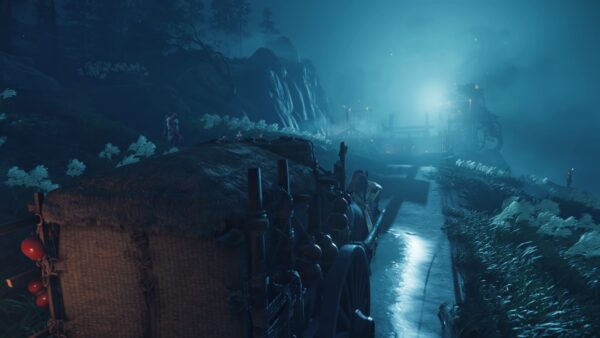
For what it’s worth the stealth is done pretty well, having all the trappings you’d expect from a modern stealth game which make for a good experience. If you heavily invest in the ghost tree you’ll also have a bunch of amped up abilities that’ll make taking out entire enemy camps without being detected a breeze. This does of course preclude you from using the standoff mechanic which, if I’m honest, is cool for the first 10 hours but then just becomes a chore as the enemies constantly taunt you and give you way less time to react making it a far less useful mechanic than it started out to be. Suffice to say I get the feeling that a mostly-ghost based play through might’ve actually been quite a lot more enjoyable given how repetitive the combat became in the later half of the game.
Progression comes at a pretty steady clip given you’ve got quite a few progression systems to push forward. The main one is technique points which is basically just a convoluted skill tree divided into 3 branches: stances, ghost abilities and samurai techniques. There’s some must have abilities which you’ll want to get (arrow deflection and self res when downed) but otherwise I ploughed most of my points into the stances to make sure I had all the tools I could to chew through the vast number of enemies that got thrown at me. This made some encounters a bit easier, especially once I unlocked the bruiser stance, but otherwise it didn’t seem to give me as much of an edge as I’d hoped. Following on from that is the usual array of gear upgrades (attained through getting crafting materials and bringing it to the right vendor) and other various miscellaneous upgrades that come from exploring.
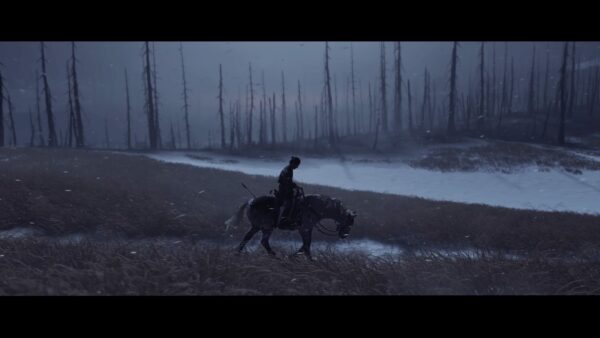
Exploration is a rewarding endeavour too, made all the better by the use of the “follow the damn golden bird mechanic” which helps to guide you towards unlockables once you’re in the general area. This makes riding directly (or as close as you can manage it) from one point to another really worth it as it’s quite likely you’ll stumble upon a bird that’ll lead you to something. It doesn’t always work flawlessly, the birds also like to fly straight paths, and that can get a little wonky when you but up against a large wall or some other obstacle which just seems to make them despawn. Still with a beautiful environment to explore and rewards to be had there’s just simply no reason not to indulge in it.
The plot is, if I’m brutally honest, a little mediocre due to the way it evolves which feels extremely contrary to the way your character is initially built up. I admit that part of this is due to my abstinence from using ghost abilities and that having zero impact on how the story evolves but when your character visibly struggles with it and other characters in the game chide you for it (even when you have no choice) I feel like this was a story being forced upon me rather than one I was playing an active part in. Don’t get me wrong, I think most of the strongest games I’ve played have been on narrative rails, but they felt a lot truer to their characters and world than Ghost of Tsushima did. There were a couple moments that stood out to me though, and I can definitely say that I felt it wrapped up to my satisfaction, so whilst it might be mediocre it certainly avoided some of the more grievous sins I’ve witnessed games commit of late.
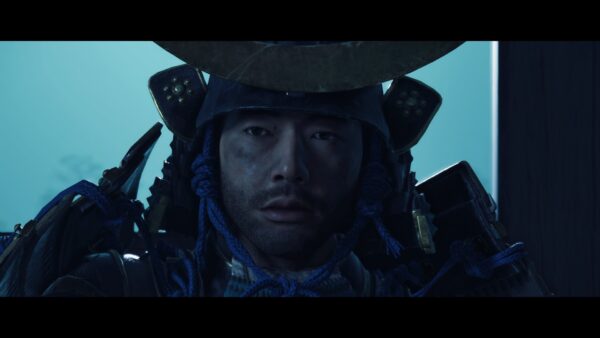
Ghost of Tsushima is the kind of game that we only get to see come around at the end of a console generation: one that pushes the console to its limits whilst also bringing with it the trappings of a game that I’m sure is to the delight of many open world fans. It’s going to be many nights of forum posts and Twitter threads as to which last of generation console game looks best but in the end it’s us as consumers of these games who win out in the long run. The game itself is a very standard open world affair with a few unique things sprinkled through it to change it up a little bit. In the end the story is somewhat middle of the road but skips over some of the bigger mistakes that other games have made. All in all I think it’s a competent game but it’s not something I’ll find myself coming back to in order to Platinum it. I certainly enjoyed it but it’s far from game of the year material in my mind.
Rating: 8.5/10
Ghost of Tsushima is available exclusively on PlayStation 4 right now for $79. Total play time was approximately 20 hours with 35% of the achievements unlocked.



